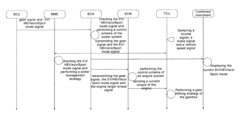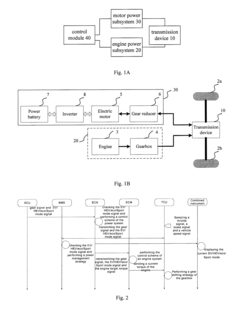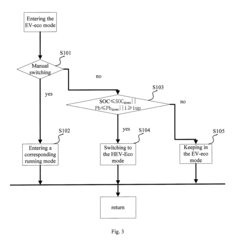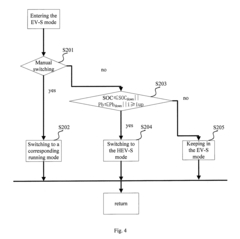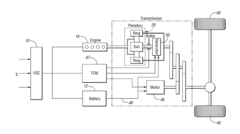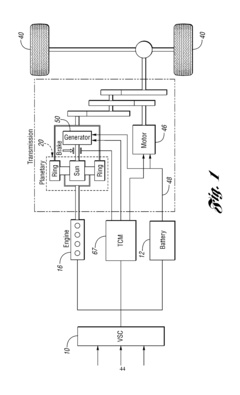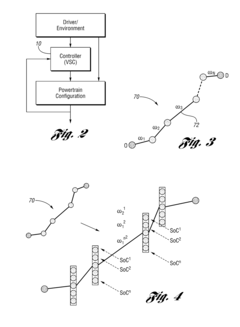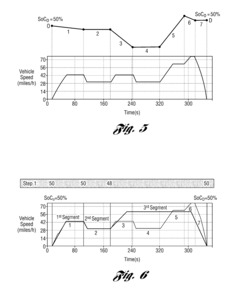Understanding HEV's Impact on Rural Transportation
AUG 14, 20259 MIN READ
Generate Your Research Report Instantly with AI Agent
Patsnap Eureka helps you evaluate technical feasibility & market potential.
HEV Rural Transport Background and Objectives
Hybrid Electric Vehicles (HEVs) have emerged as a promising solution to address the growing concerns of environmental sustainability and energy efficiency in the transportation sector. As the world grapples with the challenges of climate change and depleting fossil fuel resources, HEVs offer a bridge between conventional internal combustion engine vehicles and fully electric vehicles. This technology combines the benefits of both electric and gasoline-powered propulsion systems, providing improved fuel economy and reduced emissions.
The evolution of HEV technology can be traced back to the late 19th century, with early experiments in electric and hybrid propulsion. However, it wasn't until the late 20th century that HEVs gained significant traction, driven by advancements in battery technology, power electronics, and control systems. The launch of the Toyota Prius in 1997 marked a turning point, demonstrating the commercial viability of HEVs and sparking widespread interest in hybrid technology.
In the context of rural transportation, HEVs present unique opportunities and challenges. Rural areas often face distinct transportation needs compared to urban environments, including longer travel distances, limited charging infrastructure, and diverse terrain conditions. Understanding the impact of HEVs on rural transportation is crucial for developing effective strategies to enhance mobility, reduce environmental impact, and improve energy efficiency in these regions.
The primary objective of this technical research is to comprehensively analyze the potential of HEVs in transforming rural transportation systems. This involves examining the current state of HEV technology, assessing its adaptability to rural environments, and identifying key areas for improvement. The research aims to explore how HEVs can address specific rural transportation challenges, such as limited public transport options, high fuel costs, and the need for vehicles capable of handling diverse road conditions.
Furthermore, this study seeks to evaluate the economic implications of HEV adoption in rural areas, considering factors such as initial vehicle costs, fuel savings, and maintenance requirements. It will also investigate the environmental benefits, including reduced greenhouse gas emissions and improved air quality, which are particularly relevant in preserving rural landscapes and ecosystems.
By analyzing these aspects, the research intends to provide valuable insights for policymakers, automotive manufacturers, and rural communities. These findings will contribute to informed decision-making regarding the integration of HEVs into rural transportation systems, potentially leading to more sustainable and efficient mobility solutions for rural populations.
The evolution of HEV technology can be traced back to the late 19th century, with early experiments in electric and hybrid propulsion. However, it wasn't until the late 20th century that HEVs gained significant traction, driven by advancements in battery technology, power electronics, and control systems. The launch of the Toyota Prius in 1997 marked a turning point, demonstrating the commercial viability of HEVs and sparking widespread interest in hybrid technology.
In the context of rural transportation, HEVs present unique opportunities and challenges. Rural areas often face distinct transportation needs compared to urban environments, including longer travel distances, limited charging infrastructure, and diverse terrain conditions. Understanding the impact of HEVs on rural transportation is crucial for developing effective strategies to enhance mobility, reduce environmental impact, and improve energy efficiency in these regions.
The primary objective of this technical research is to comprehensively analyze the potential of HEVs in transforming rural transportation systems. This involves examining the current state of HEV technology, assessing its adaptability to rural environments, and identifying key areas for improvement. The research aims to explore how HEVs can address specific rural transportation challenges, such as limited public transport options, high fuel costs, and the need for vehicles capable of handling diverse road conditions.
Furthermore, this study seeks to evaluate the economic implications of HEV adoption in rural areas, considering factors such as initial vehicle costs, fuel savings, and maintenance requirements. It will also investigate the environmental benefits, including reduced greenhouse gas emissions and improved air quality, which are particularly relevant in preserving rural landscapes and ecosystems.
By analyzing these aspects, the research intends to provide valuable insights for policymakers, automotive manufacturers, and rural communities. These findings will contribute to informed decision-making regarding the integration of HEVs into rural transportation systems, potentially leading to more sustainable and efficient mobility solutions for rural populations.
Rural Market Demand for HEVs
The rural market demand for Hybrid Electric Vehicles (HEVs) is experiencing a significant shift as these vehicles gain traction beyond urban centers. Rural communities, traditionally perceived as less receptive to new automotive technologies, are showing increasing interest in HEVs due to their potential economic and environmental benefits.
One of the primary drivers of HEV demand in rural areas is the potential for long-term cost savings. Rural residents often face longer commutes and higher fuel consumption due to the dispersed nature of their communities. HEVs offer improved fuel efficiency, which can translate to substantial savings over time. This economic incentive is particularly appealing in rural areas where household incomes may be lower than in urban centers.
Environmental consciousness is also playing a role in the growing rural demand for HEVs. As awareness of climate change and its impacts on agriculture and rural landscapes increases, more rural residents are seeking ways to reduce their carbon footprint. HEVs provide a practical solution that allows for reduced emissions without sacrificing the utility and range needed for rural lifestyles.
The agricultural sector represents a significant potential market for HEVs in rural areas. Farmers and agricultural businesses are exploring HEV technology for various applications, from personal transportation to light-duty farm vehicles. The ability of HEVs to provide portable power sources is particularly attractive for remote agricultural operations.
Infrastructure development is both a challenge and an opportunity in rural HEV adoption. While the current charging infrastructure in many rural areas is limited, there is growing investment in expanding these networks. This expansion is not only driven by automotive demand but also by the potential for rural communities to become part of a broader, more resilient energy grid.
Government incentives and rural development programs are also influencing HEV demand in rural markets. Many countries and regions are offering specific incentives for rural HEV adoption as part of broader initiatives to modernize rural transportation and reduce dependence on fossil fuels.
The used HEV market is emerging as a significant factor in rural adoption. As more HEVs enter the secondary market, they become more accessible to rural buyers who may be more price-sensitive. This trend is likely to accelerate HEV penetration in rural areas over the coming years.
Despite these positive trends, challenges remain in fully realizing rural HEV demand. These include concerns about vehicle range, the availability of maintenance services, and the initial higher purchase price compared to conventional vehicles. Addressing these concerns through targeted marketing, education, and policy initiatives will be crucial in further stimulating rural HEV demand.
One of the primary drivers of HEV demand in rural areas is the potential for long-term cost savings. Rural residents often face longer commutes and higher fuel consumption due to the dispersed nature of their communities. HEVs offer improved fuel efficiency, which can translate to substantial savings over time. This economic incentive is particularly appealing in rural areas where household incomes may be lower than in urban centers.
Environmental consciousness is also playing a role in the growing rural demand for HEVs. As awareness of climate change and its impacts on agriculture and rural landscapes increases, more rural residents are seeking ways to reduce their carbon footprint. HEVs provide a practical solution that allows for reduced emissions without sacrificing the utility and range needed for rural lifestyles.
The agricultural sector represents a significant potential market for HEVs in rural areas. Farmers and agricultural businesses are exploring HEV technology for various applications, from personal transportation to light-duty farm vehicles. The ability of HEVs to provide portable power sources is particularly attractive for remote agricultural operations.
Infrastructure development is both a challenge and an opportunity in rural HEV adoption. While the current charging infrastructure in many rural areas is limited, there is growing investment in expanding these networks. This expansion is not only driven by automotive demand but also by the potential for rural communities to become part of a broader, more resilient energy grid.
Government incentives and rural development programs are also influencing HEV demand in rural markets. Many countries and regions are offering specific incentives for rural HEV adoption as part of broader initiatives to modernize rural transportation and reduce dependence on fossil fuels.
The used HEV market is emerging as a significant factor in rural adoption. As more HEVs enter the secondary market, they become more accessible to rural buyers who may be more price-sensitive. This trend is likely to accelerate HEV penetration in rural areas over the coming years.
Despite these positive trends, challenges remain in fully realizing rural HEV demand. These include concerns about vehicle range, the availability of maintenance services, and the initial higher purchase price compared to conventional vehicles. Addressing these concerns through targeted marketing, education, and policy initiatives will be crucial in further stimulating rural HEV demand.
HEV Technology Status and Rural Challenges
Hybrid Electric Vehicles (HEVs) have made significant strides in urban and suburban environments, but their impact on rural transportation presents unique challenges and opportunities. The current status of HEV technology in rural areas is characterized by a mix of promising advancements and persistent obstacles.
In terms of technological progress, HEVs have seen improvements in battery capacity, charging efficiency, and overall performance. These advancements have extended the range and reliability of HEVs, making them more viable for longer rural commutes. However, the adoption rate in rural areas lags behind urban centers due to several factors.
One of the primary challenges is the limited charging infrastructure in rural regions. The sparse population density and vast distances between towns make it economically challenging to establish a comprehensive charging network. This infrastructure gap creates range anxiety among potential rural HEV adopters, hindering widespread acceptance.
Another significant hurdle is the higher initial cost of HEVs compared to conventional vehicles. Rural communities often have lower average incomes, making the upfront investment in HEV technology a substantial barrier. While the long-term cost savings from reduced fuel consumption are evident, the initial price point remains a deterrent for many rural consumers.
The rugged terrain and harsh weather conditions common in rural areas also pose challenges for HEV technology. These vehicles must demonstrate robust performance and reliability in diverse environments, from unpaved roads to extreme temperatures. Manufacturers are working to address these issues through improved drivetrain designs and more durable battery systems.
On the positive side, the potential for HEVs to reduce fuel costs is particularly appealing in rural areas where residents often travel longer distances for work, shopping, and services. The fuel efficiency of HEVs can provide significant savings over time, especially in regions where gasoline prices tend to be higher due to transportation costs.
Additionally, the integration of renewable energy sources, such as solar and wind power, with HEV charging infrastructure presents an opportunity for rural communities to enhance their energy independence. This synergy could lead to more sustainable and resilient rural transportation systems.
The agricultural sector, a cornerstone of many rural economies, is also exploring the potential of HEV technology in farm equipment and machinery. While still in early stages, this application could revolutionize rural work practices and further drive HEV adoption in these areas.
In conclusion, while HEV technology has made notable progress, its full potential in rural transportation remains unrealized due to infrastructure limitations, economic constraints, and environmental challenges. Addressing these issues will be crucial for the widespread adoption of HEVs in rural settings and for realizing the full benefits of this technology in non-urban environments.
In terms of technological progress, HEVs have seen improvements in battery capacity, charging efficiency, and overall performance. These advancements have extended the range and reliability of HEVs, making them more viable for longer rural commutes. However, the adoption rate in rural areas lags behind urban centers due to several factors.
One of the primary challenges is the limited charging infrastructure in rural regions. The sparse population density and vast distances between towns make it economically challenging to establish a comprehensive charging network. This infrastructure gap creates range anxiety among potential rural HEV adopters, hindering widespread acceptance.
Another significant hurdle is the higher initial cost of HEVs compared to conventional vehicles. Rural communities often have lower average incomes, making the upfront investment in HEV technology a substantial barrier. While the long-term cost savings from reduced fuel consumption are evident, the initial price point remains a deterrent for many rural consumers.
The rugged terrain and harsh weather conditions common in rural areas also pose challenges for HEV technology. These vehicles must demonstrate robust performance and reliability in diverse environments, from unpaved roads to extreme temperatures. Manufacturers are working to address these issues through improved drivetrain designs and more durable battery systems.
On the positive side, the potential for HEVs to reduce fuel costs is particularly appealing in rural areas where residents often travel longer distances for work, shopping, and services. The fuel efficiency of HEVs can provide significant savings over time, especially in regions where gasoline prices tend to be higher due to transportation costs.
Additionally, the integration of renewable energy sources, such as solar and wind power, with HEV charging infrastructure presents an opportunity for rural communities to enhance their energy independence. This synergy could lead to more sustainable and resilient rural transportation systems.
The agricultural sector, a cornerstone of many rural economies, is also exploring the potential of HEV technology in farm equipment and machinery. While still in early stages, this application could revolutionize rural work practices and further drive HEV adoption in these areas.
In conclusion, while HEV technology has made notable progress, its full potential in rural transportation remains unrealized due to infrastructure limitations, economic constraints, and environmental challenges. Addressing these issues will be crucial for the widespread adoption of HEVs in rural settings and for realizing the full benefits of this technology in non-urban environments.
Current HEV Solutions for Rural Areas
01 Thermal management systems for HEVs
Hybrid Electric Vehicles (HEVs) require efficient thermal management systems to regulate the temperature of various components, including batteries, electric motors, and power electronics. These systems often incorporate cooling circuits, heat exchangers, and temperature sensors to maintain optimal operating conditions and improve overall vehicle performance.- Thermal management systems for HEVs: Hybrid Electric Vehicles (HEVs) require efficient thermal management systems to regulate the temperature of various components, including batteries, electric motors, and power electronics. These systems often incorporate advanced cooling techniques, heat exchangers, and temperature control mechanisms to optimize performance and extend the lifespan of critical components.
- Power distribution and control in HEVs: HEVs utilize sophisticated power distribution and control systems to manage the flow of energy between the internal combustion engine, electric motor(s), and battery pack. These systems optimize power delivery, improve fuel efficiency, and enhance overall vehicle performance through intelligent energy management strategies and advanced control algorithms.
- Battery technologies for HEVs: Advanced battery technologies play a crucial role in HEVs, focusing on improving energy density, charging efficiency, and overall lifespan. Innovations in battery chemistry, cell design, and thermal management contribute to enhanced performance and range of hybrid vehicles.
- Regenerative braking systems in HEVs: Regenerative braking systems in HEVs capture and convert kinetic energy into electrical energy during deceleration or braking, storing it in the battery for later use. These systems improve overall energy efficiency and extend the electric driving range of hybrid vehicles.
- Hybrid powertrain configurations: Various hybrid powertrain configurations are employed in HEVs, including series, parallel, and power-split architectures. These designs optimize the integration of internal combustion engines and electric motors to achieve the best balance of performance, efficiency, and cost-effectiveness for different vehicle types and driving conditions.
02 Power control and distribution in HEVs
HEVs utilize sophisticated power control and distribution systems to manage the flow of energy between the internal combustion engine, electric motor(s), and battery pack. These systems optimize power usage, improve fuel efficiency, and enhance vehicle performance through intelligent control algorithms and power electronics.Expand Specific Solutions03 Battery technologies for HEVs
Advanced battery technologies are crucial for HEVs, focusing on improving energy density, charging efficiency, and lifespan. Innovations in battery chemistry, cell design, and battery management systems contribute to enhanced range, performance, and reliability of hybrid vehicles.Expand Specific Solutions04 Regenerative braking systems in HEVs
Regenerative braking systems in HEVs capture and convert kinetic energy into electrical energy during deceleration, storing it in the battery for later use. These systems improve overall energy efficiency and extend the electric driving range of hybrid vehicles.Expand Specific Solutions05 Hybrid powertrain configurations
Various hybrid powertrain configurations are employed in HEVs, including series, parallel, and power-split architectures. These designs optimize the integration of internal combustion engines and electric motors to achieve the best balance of performance, efficiency, and cost-effectiveness for different vehicle types and driving conditions.Expand Specific Solutions
Key HEV Manufacturers and Rural Market Players
The market for hybrid electric vehicles (HEVs) in rural transportation is in a growth phase, with increasing adoption driven by environmental concerns and fuel efficiency. The global HEV market size is projected to expand significantly in the coming years, though rural areas may lag behind urban centers in adoption rates. Technologically, HEVs are relatively mature, with major automakers like Toyota, Ford, and Hyundai offering established models. However, ongoing innovations in battery technology, led by companies such as LG Energy Solution and Panasonic, continue to improve HEV performance and range. Emerging players like BYD and Great Wall Motor are also making strides in HEV development, particularly for emerging markets.
GM Global Technology Operations LLC
Technical Solution: GM has developed the "Rural Mobility Platform" (RMP), a modular hybrid electric vehicle system designed to address the specific needs of rural transportation. The RMP utilizes a flexible powertrain that can be easily adapted to various vehicle types, from personal cars to small buses, catering to diverse rural transportation needs[2]. GM's system incorporates an intelligent power distribution system that optimizes the use of electric and combustion power based on real-time road conditions and load requirements[4]. The company has also integrated a robust telematics system that provides valuable data on vehicle performance and maintenance needs, crucial for remote rural areas where service centers may be scarce[6].
Strengths: Modular design for versatility, intelligent power management, remote diagnostics capabilities. Weaknesses: May require specialized training for rural mechanics, potential over-reliance on connectivity in areas with poor network coverage.
Toyota Motor Corp.
Technical Solution: Toyota has developed a hybrid system specifically designed for rural areas called the "Rural Hybrid System" (RHS). This system combines a small diesel engine with an electric motor, optimized for the unique demands of rural transportation. The RHS incorporates advanced energy management algorithms that adapt to varying road conditions and driving patterns typical in rural settings[1]. Toyota has also implemented a regenerative braking system that is particularly effective on unpaved roads, capturing energy that would otherwise be lost during frequent stops and starts[3]. Additionally, the company has introduced a "Smart Charge" feature that allows the vehicle to be charged using various rural power sources, including solar panels and small-scale wind turbines, enhancing the system's versatility in areas with limited charging infrastructure[5].
Strengths: Tailored for rural conditions, efficient energy recovery on rough terrain, flexible charging options. Weaknesses: May have higher initial costs, potential complexity for rural maintenance.
Key HEV Innovations for Rural Applications
Hybrid electrical vehicle and method for controlling same
PatentActiveUS20160221571A1
Innovation
- A control system and method for a hybrid electrical vehicle that allows switching between EV and HEV modes based on battery power and slope conditions, enabling parallel connection of engine and motor power subsystems to improve energy utilization and reduce complex transmission requirements.
Hybrid electric vehicle and method of path dependent receding horizon control
PatentActiveUS20120010768A1
Innovation
- Implementing a path-dependent control method that segments routes into smaller segments, generates virtual routes with optimized battery state-of-charge (SoC) set-points, and uses a Receding Horizon Control (RHC) algorithm to minimize fuel consumption by adjusting battery charging and discharging based on road characteristics and traffic conditions.
Rural Infrastructure for HEV Adoption
The adoption of Hybrid Electric Vehicles (HEVs) in rural areas presents unique challenges and opportunities for infrastructure development. Rural regions often lack the necessary charging infrastructure to support widespread HEV use, requiring significant investments in charging stations and grid upgrades. The dispersed nature of rural populations means that charging stations must be strategically placed to serve a wider area, potentially along major highways and in town centers.
Existing electrical grids in rural areas may need substantial reinforcement to handle the increased load from HEV charging. This could involve upgrading transformers, power lines, and substations to ensure reliable power delivery. Smart grid technologies could be implemented to manage the additional demand and optimize charging schedules, particularly during off-peak hours.
Rural gas stations and convenience stores may need to adapt their business models to incorporate HEV charging services. This could include installing fast-charging stations and offering amenities to occupy drivers during charging times. Local businesses could benefit from increased foot traffic as HEV owners spend time in the area while their vehicles charge.
Road infrastructure may also require modifications to accommodate HEVs. This could include the installation of clear signage indicating charging station locations and the integration of charging information into GPS and mapping systems. Additionally, parking areas in rural towns and tourist destinations may need to be redesigned to include charging spots.
Public transportation in rural areas could be revolutionized by HEV technology. Electric buses and shuttles could provide cleaner, more efficient transportation options for rural residents, potentially increasing mobility for those without personal vehicles. This would require the development of dedicated charging depots and the training of local mechanics in HEV maintenance.
The implementation of HEV infrastructure in rural areas also presents an opportunity for job creation and skill development. Local workers could be trained in the installation and maintenance of charging stations, as well as in HEV repair and servicing. This could help diversify rural economies and provide new career paths for residents.
Lastly, the integration of renewable energy sources, such as solar and wind power, could be coupled with HEV infrastructure development. This would not only support the green credentials of HEV adoption but also enhance energy independence for rural communities, potentially leading to more resilient and sustainable local energy systems.
Existing electrical grids in rural areas may need substantial reinforcement to handle the increased load from HEV charging. This could involve upgrading transformers, power lines, and substations to ensure reliable power delivery. Smart grid technologies could be implemented to manage the additional demand and optimize charging schedules, particularly during off-peak hours.
Rural gas stations and convenience stores may need to adapt their business models to incorporate HEV charging services. This could include installing fast-charging stations and offering amenities to occupy drivers during charging times. Local businesses could benefit from increased foot traffic as HEV owners spend time in the area while their vehicles charge.
Road infrastructure may also require modifications to accommodate HEVs. This could include the installation of clear signage indicating charging station locations and the integration of charging information into GPS and mapping systems. Additionally, parking areas in rural towns and tourist destinations may need to be redesigned to include charging spots.
Public transportation in rural areas could be revolutionized by HEV technology. Electric buses and shuttles could provide cleaner, more efficient transportation options for rural residents, potentially increasing mobility for those without personal vehicles. This would require the development of dedicated charging depots and the training of local mechanics in HEV maintenance.
The implementation of HEV infrastructure in rural areas also presents an opportunity for job creation and skill development. Local workers could be trained in the installation and maintenance of charging stations, as well as in HEV repair and servicing. This could help diversify rural economies and provide new career paths for residents.
Lastly, the integration of renewable energy sources, such as solar and wind power, could be coupled with HEV infrastructure development. This would not only support the green credentials of HEV adoption but also enhance energy independence for rural communities, potentially leading to more resilient and sustainable local energy systems.
Environmental Impact of HEVs in Rural Settings
The environmental impact of Hybrid Electric Vehicles (HEVs) in rural settings is a complex and multifaceted issue that requires careful consideration. HEVs offer significant potential for reducing greenhouse gas emissions and improving air quality in rural areas, where traditional internal combustion engine vehicles have long been the primary mode of transportation.
One of the key benefits of HEVs in rural environments is their ability to reduce fuel consumption and emissions during low-speed driving and idling, which are common scenarios in rural areas with frequent stops and starts. This can lead to a substantial decrease in local air pollutants such as particulate matter, nitrogen oxides, and carbon monoxide, which are known to have adverse effects on human health and the environment.
Furthermore, the reduced noise pollution associated with HEVs can have a positive impact on rural ecosystems. The quieter operation of these vehicles, especially at low speeds, can help minimize disturbances to wildlife and preserve the tranquility of rural landscapes. This is particularly important in areas with sensitive habitats or endangered species that may be affected by noise from traditional vehicles.
However, the environmental benefits of HEVs in rural settings are not without challenges. The production and disposal of batteries used in these vehicles can have significant environmental implications. The mining of raw materials for battery production, such as lithium and cobalt, can lead to habitat destruction and water pollution if not properly managed. Additionally, the lack of proper recycling infrastructure in many rural areas may pose challenges for the safe disposal of end-of-life batteries.
Another consideration is the source of electricity used to charge HEVs in rural areas. If the local power grid relies heavily on fossil fuels, the overall environmental benefits of HEVs may be diminished. However, the integration of renewable energy sources, such as solar and wind power, into rural electricity grids can enhance the environmental advantages of HEVs and contribute to a more sustainable transportation ecosystem.
The adoption of HEVs in rural settings also has the potential to influence land use patterns and agricultural practices. As these vehicles become more prevalent, there may be opportunities to develop more efficient and environmentally friendly transportation networks that better serve rural communities while minimizing the impact on natural habitats and farmland.
In conclusion, while HEVs offer significant environmental benefits for rural transportation, their impact must be evaluated holistically, considering factors such as battery production, electricity sources, and long-term sustainability. Proper planning and infrastructure development will be crucial to maximizing the positive environmental effects of HEVs in rural settings while mitigating potential drawbacks.
One of the key benefits of HEVs in rural environments is their ability to reduce fuel consumption and emissions during low-speed driving and idling, which are common scenarios in rural areas with frequent stops and starts. This can lead to a substantial decrease in local air pollutants such as particulate matter, nitrogen oxides, and carbon monoxide, which are known to have adverse effects on human health and the environment.
Furthermore, the reduced noise pollution associated with HEVs can have a positive impact on rural ecosystems. The quieter operation of these vehicles, especially at low speeds, can help minimize disturbances to wildlife and preserve the tranquility of rural landscapes. This is particularly important in areas with sensitive habitats or endangered species that may be affected by noise from traditional vehicles.
However, the environmental benefits of HEVs in rural settings are not without challenges. The production and disposal of batteries used in these vehicles can have significant environmental implications. The mining of raw materials for battery production, such as lithium and cobalt, can lead to habitat destruction and water pollution if not properly managed. Additionally, the lack of proper recycling infrastructure in many rural areas may pose challenges for the safe disposal of end-of-life batteries.
Another consideration is the source of electricity used to charge HEVs in rural areas. If the local power grid relies heavily on fossil fuels, the overall environmental benefits of HEVs may be diminished. However, the integration of renewable energy sources, such as solar and wind power, into rural electricity grids can enhance the environmental advantages of HEVs and contribute to a more sustainable transportation ecosystem.
The adoption of HEVs in rural settings also has the potential to influence land use patterns and agricultural practices. As these vehicles become more prevalent, there may be opportunities to develop more efficient and environmentally friendly transportation networks that better serve rural communities while minimizing the impact on natural habitats and farmland.
In conclusion, while HEVs offer significant environmental benefits for rural transportation, their impact must be evaluated holistically, considering factors such as battery production, electricity sources, and long-term sustainability. Proper planning and infrastructure development will be crucial to maximizing the positive environmental effects of HEVs in rural settings while mitigating potential drawbacks.
Unlock deeper insights with Patsnap Eureka Quick Research — get a full tech report to explore trends and direct your research. Try now!
Generate Your Research Report Instantly with AI Agent
Supercharge your innovation with Patsnap Eureka AI Agent Platform!
